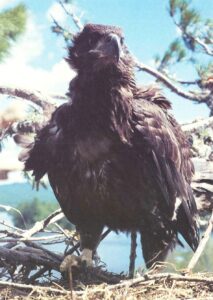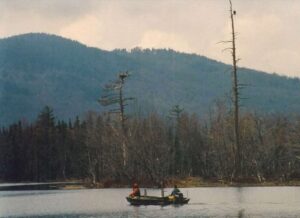(by Chris Martin)
In the 1950s – 20 years prior to passage of the federal Endangered Species Act – people saw Bald Eagles in all the usual places; along major rivers, on inland lakes, and in coastal marshes. Things seemed fine. The problem was that adult eagle pairs were not fledging young… year after year after year. DDT, a synthetic insecticide first used widely in the 1940s, was accumulating in breeding eagles and causing them to lay thin-shelled eggs that failed to hatch. Soon there were almost no immature eagles left in the U.S. When that older generation of eagles died, there weren’t any young birds to replace them. Suddenly the population crashed!
In the 1960’s, National Audubon monitored nesting eagles at sites across the U.S. Rachel Carson authored Silent Spring, a best-seller that told the story of the threat that industrial pesticides posed to our wildlife and the environment. Growing concern and activism led to the creation of the federal Environmental Protection Agency in 1970 and then to the passage of the Endangered Species Act in 1973. While working for the U.S. Fish & Wildlife Service in 1972-73, current NH Audubon trustee Paul Nickerson coordinated national eagle nesting surveys. Nickerson recalls, “We estimated 1000 pairs in the Lower 48. From 1974-76, we brought viable eggs from Minnesota to Maine to improve reproductive success.”

Passage of the ESA triggered federal and state wildlife agencies to take action, and equally important, it created a federal funding mechanism. Closer to home in New England and New York, wildlife biologists began working together to coordinate recovery efforts. New York, Massachusetts, and Maine all started translocating and releasing juvenile eagles acquired from Alaska, Minnesota, and Nova Scotia (where populations were better off) through a process called hacking. The NH Legislature passed the state’s Endangered Species Conservation Act in 1979. NH Fish & Game and NH Audubon partnered to establish the Endangered Species Program, precursor to our current Nongame and Endangered Wildlife Program.
Inspired professionals like Nickerson, as well as New York’s Pete Nye, and New Hampshire’s Flip Nevers, Carol Foss, and Michael Amaral rallied others to the cause. And this included recruiting NH Audubon field biologist Diane Evans and our first volunteer eagle nest-watchers, Sandy and Mark Turner. We fostered young eagles into nests, placed ID bands on eaglets to track their dispersal and longevity as adults, and collected blood and feather samples to identify toxins. We placed predator guards on nest trees and reached out to offer landowner assistance.

New Hampshire’s breeding Bald Eagle population grew from one breeding pair at Umbagog in the 1990s to roughly 20 pairs across the state in the late 2000s to over 100 pairs today. Bald Eagles remained federally ‘Endangered’ until 1995, when they were downlisted to ‘Threatened’. When they were removed from the ESA’s Threatened List in 2007, there were estimated to be 10,000 nesting pairs in the Lower 48. Today that number is well beyond 100,000 pairs!
Credit is due to the ESA and the banning of DDT for making all these gains possible. According to Nickerson, “The ban on use of DDT in North America set the stage for population recovery since an abundance of nesting habitat was available. The ultimate testimony to the success of the recovery was removal from the federal Endangered Species list.”
Retired New York State eagle biologist Pete Nye tells an amazing story of the comeback of Bald Eagles in New York and New England in a beautiful video here.
